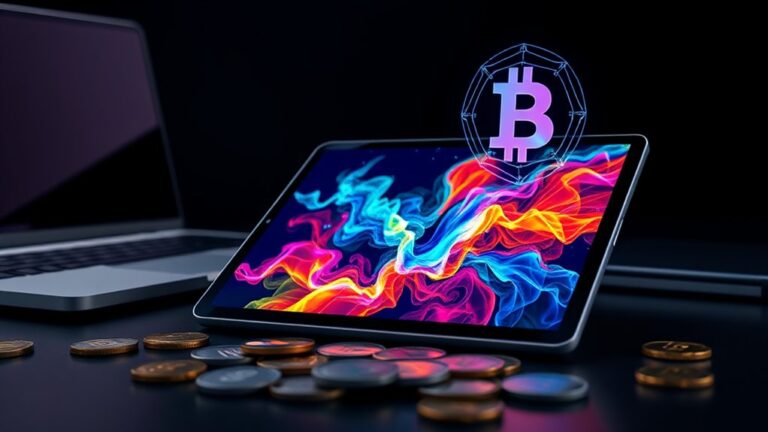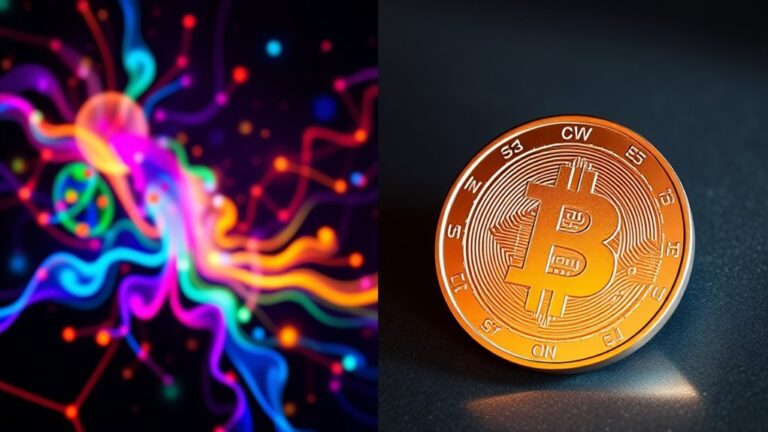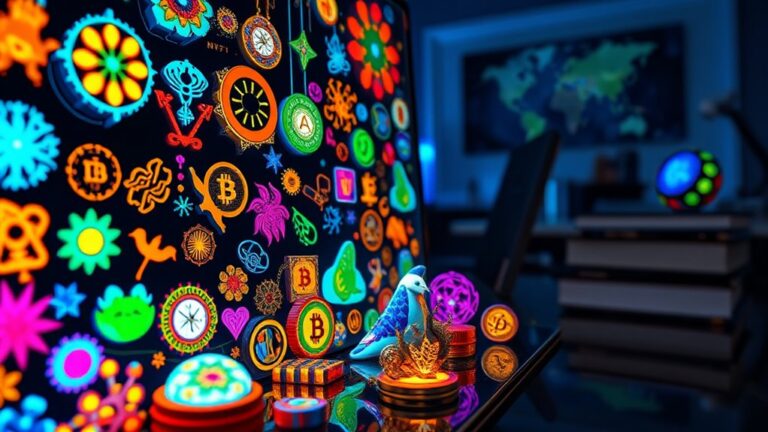
Fractionalized NFTs: Enhancing Accessibility and Liquidity in Crypto
Fractionalized NFTs (FNFTs) enhance accessibility and liquidity in the crypto space by allowing multiple individuals to own shares of high-value digital assets. This process involves dividing a single NFT into smaller, tradable parts using smart contracts. FNFTs democratize ownership, increase market activity, and reduce investment risk. They also support better price discovery through continuous trading. Understanding the mechanics of FNFTs can reveal their impact on various industries and the potential challenges they may face in the market.
Key Takeaways
- Fractional NFTs democratize ownership, allowing multiple investors to participate in high-value digital assets like rare art or collectibles.
- They enhance market liquidity by enabling the trading of smaller, more affordable NFT fractions, increasing overall trading activity.
- Fractionalization reduces investment risk by allowing diversification through smaller investments, making it accessible for more individuals.
- The use of smart contracts ensures secure ownership rights and simplifies the trading process for fractionalized assets.
- Continuous trading of FNFTs promotes better price discovery, leading to accurate valuations and reduced market volatility.
Understanding Fractionalized NFTs

Understanding Fractionalized NFTs begins with recognizing what they are and how they function within the digital asset landscape.
Fractional NFTs (FNFTs) allow collective ownership of a single NFT by dividing it into smaller, tradable parts. This process involves utilizing smart contracts to break down the NFT, making it more accessible to a wider audience.
Each fraction can be traded like a regular NFT or fungible token, enhancing liquidity. FNFTs typically combine ERC721 and ERC20 token standards, representing both non-fungible and fungible ownership.
The original NFT owner determines the number of fractions and their prices, enabling ownership of valuable digital assets, such as rare artworks or collectibles, which might otherwise be unaffordable for individual buyers.
Benefits of Fractionalization in the NFT Market

As the demand for digital assets continues to rise, the benefits of fractionalization in the NFT market become increasingly significant. Fractionalization democratizes ownership, allowing multiple individuals to invest in high-value NFTs. This approach increases liquidity, enabling easier trading and market activity. Additionally, it supports price discovery, as more fractions traded contribute to accurate valuations.
| Benefit | Description | Impact |
|---|---|---|
| Democratization | Multiple ownership of NFTs | Broader access for investors |
| Increased Liquidity | Smaller, tradable parts enhance trading | More vibrant market activity |
| Reduced Risk | Diversification through smaller investments | Lower exposure to loss |
| Community Building | Shared ownership fosters connections among holders | Strengthened community ties |
These advantages contribute to a more dynamic and accessible NFT marketplace. Moreover, the rise of utility NFTs highlights the potential for enhanced value and engagement in fractionalized ownership models.
The Process of Creating Fractionalized NFTs

Creating fractionalized NFTs involves a systematic process that allows for the division of ownership of a single digital asset into multiple, smaller parts.
First, an NFT, such as digital art or music, is selected for fractionalization. Next, a platform like Fractional.art or NIFTEX is chosen to facilitate the process.
To begin fractionalizing an NFT, select a digital asset and choose a platform like Fractional.art or NIFTEX for support.
Smart contracts are then generated to define ownership rights, guaranteeing security. The NFT is locked in a secure vault, initiating fractionalization.
Following this, fungible tokens (ERC-20) representing ownership fractions are minted. The smart contracts are developed using Solidity, with essential functions implemented for managing transactions.
Finally, thorough testing and auditing of these contracts guarantee their functionality and security before deployment, paving the way for fractional ownership in the NFT space.
Impact on Market Liquidity and Price Discovery

The impact of fractionalized NFTs on market liquidity and price discovery is significant, as they transform how digital assets are bought and sold.
By enabling the trading of smaller portions of NFTs, fractionalization increases transaction frequency and reduces issues related to thin order books. This enhanced liquidity attracts investors seeking active markets, fostering a more dynamic trading environment.
Additionally, the continuous buying and selling of fractions promotes better price discovery, as market forces can more effectively influence value. This consistent trading activity helps establish accurate prices and can reduce market volatility by spreading risk among a larger group of investors.
Applications Across Various Industries

Fractionalized NFTs have begun to find applications across various industries, revolutionizing how assets are owned and traded.
In real estate, they allow for the tokenization of properties, enabling investors to own shares of buildings or land, thereby increasing market efficiency.
In fashion, fractional ownership democratizes access to luxury items, promoting collaborative consumption and brand engagement.
Additionally, in intellectual property management, fractional NFTs facilitate shared ownership of patents and copyrights, enhancing monetization opportunities for creators.
This innovative approach makes high-value digital assets more accessible and lowers financial barriers for potential investors. Notably, Virtual Land NFTs represent a growing sector where fractional ownership can further enhance investment opportunities in the metaverse.
Future Prospects and Market Challenges

As fractionalized NFTs continue to reshape various industries, their future prospects are accompanied by both significant opportunities and notable challenges. Increased adoption is anticipated as more platforms support these assets, enhancing accessibility and liquidity.
Integration with decentralized finance (DeFi) will further expand their utility, fostering community building among fractional owners. However, complexities in managing ownership may deter some investors, while price volatility poses financial risks.
Additionally, concerns about market saturation could diminish the value of fractional NFTs. Security and interoperability issues present further challenges, as trust remains vital in this evolving landscape. Furthermore, the rise of utility-driven NFTs indicates a growing preference for tokens that provide tangible benefits beyond ownership.
Ultimately, while fractionalized NFTs offer new investment avenues, addressing these market challenges will be essential for their sustained growth and success.
Legal and Regulatory Considerations

Legal and regulatory considerations surrounding fractionalized NFTs are increasingly important as their popularity grows. Ownership rights in fractional NFTs can be complex, raising questions about the rights to the underlying assets.
Additionally, these NFTs may be classified as securities, which subjects them to strict registration and disclosure requirements. Intellectual property issues can arise, particularly regarding copyright and usage rights among owners.
Consumer protection laws may also apply to safeguard investors, complicating transactions. Tax implications remain uncertain, adding to legal confusion.
Moreover, cross-border regulatory challenges exist due to varying laws across jurisdictions. Clear guidelines from regulatory bodies are needed to address these issues while balancing innovation and investor protection in the evolving landscape of fractionalized NFTs.
Frequently Asked Questions
How Can I Buy Fractionalized NFTS?
To buy fractionalized NFTs, one can visit decentralized marketplaces, acquire fractional tokens representing shared ownership, utilize smart contracts for secure transactions, and navigate listings to purchase at accessible price points, thereby democratizing investment opportunities.
What Fees Are Associated With Trading Fractional NFTS?
Trading fractional NFTs incurs various fees, including marketplace transaction fees, smart contract execution fees, compliance costs, and potential auction participation charges. These costs can vary considerably across different platforms and markets, impacting overall investment expenses.
Can Fractional NFTS Be Converted Back to Full NFTS?
Converting fractional NFTs back to full NFTs is a complex dance, requiring the purchase of all fractions from various owners. This intricate process, governed by smart contracts, often faces challenges like reluctant sellers and market liquidity concerns.
What Happens if the Original NFT Is Lost or Damaged?
If the original NFT is lost or damaged, fractional owners may face significant challenges. Recovery mechanisms like buyback agreements and community support can assist, but legal frameworks and technical backups are essential for safeguarding ownership rights.
Are There Any Tax Implications for Owning Fractional NFTS?
Owning fractional NFTs is like steering through a labyrinth; it requires careful planning. Tax implications can arise from sales or trades, triggering capital gains tax, making professional guidance essential for clarity in this intricate landscape.
Conclusion
In conclusion, fractionalized NFTs serve as a bridge between high-value digital assets and the average investor, akin to sharing a pizza where each slice represents ownership. This innovative approach enhances accessibility and liquidity in the cryptocurrency landscape. However, as the market evolves, challenges such as legal complexities and regulatory scrutiny may arise. Ultimately, while fractionalization opens doors, it also leads to a cautionary tale of maneuvering an uncharted digital frontier.












